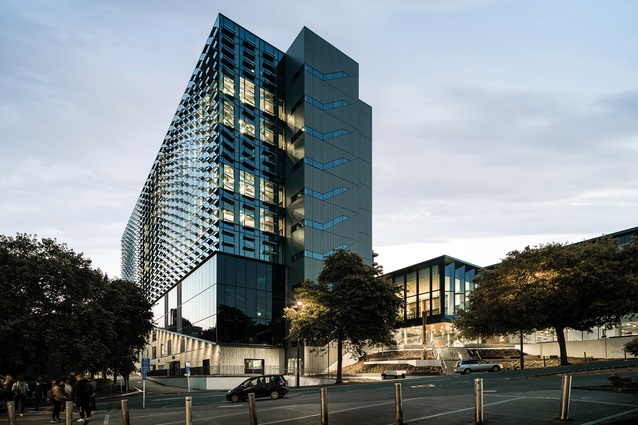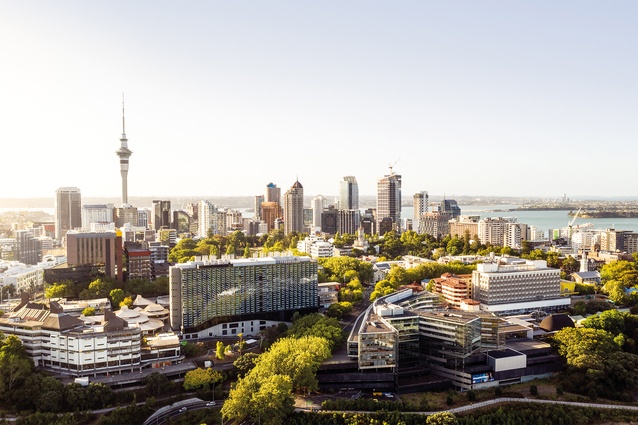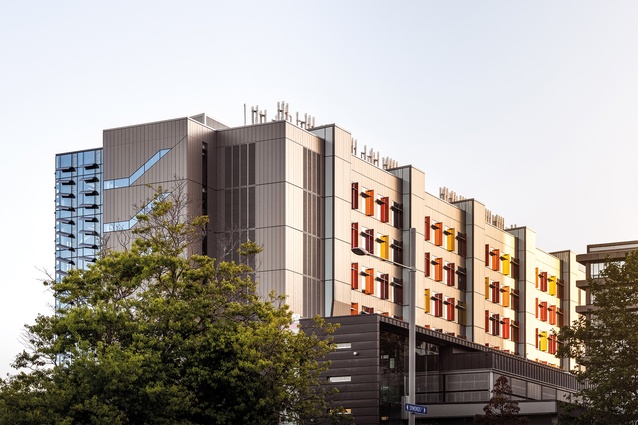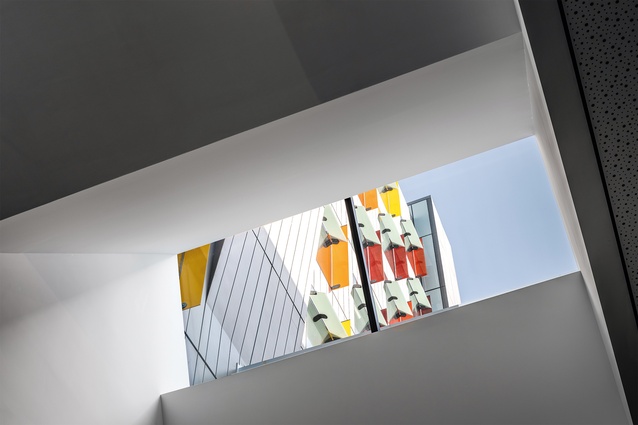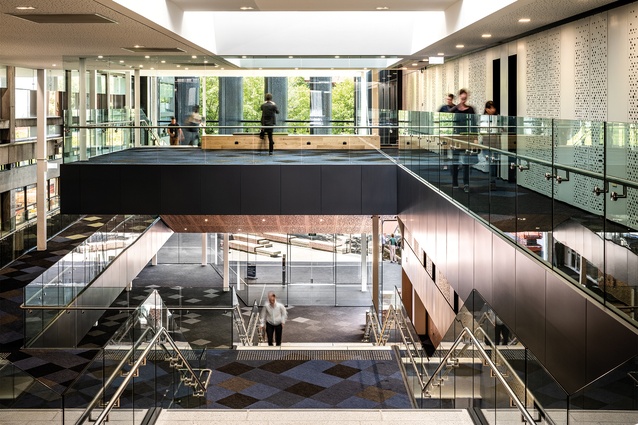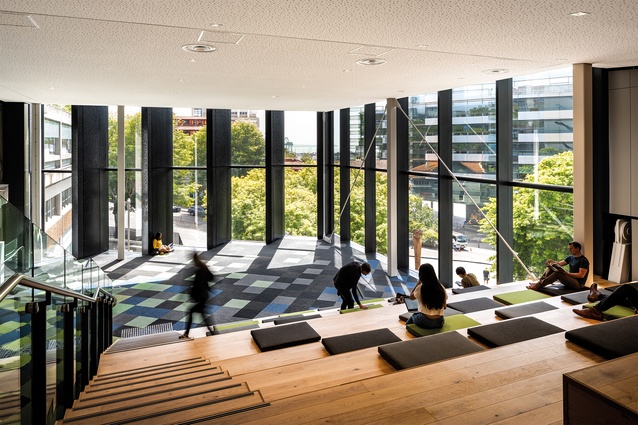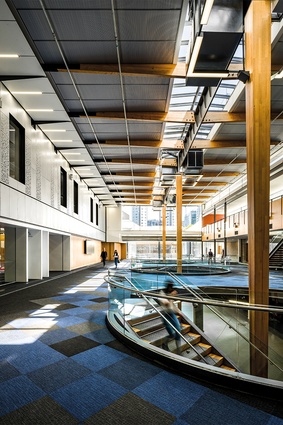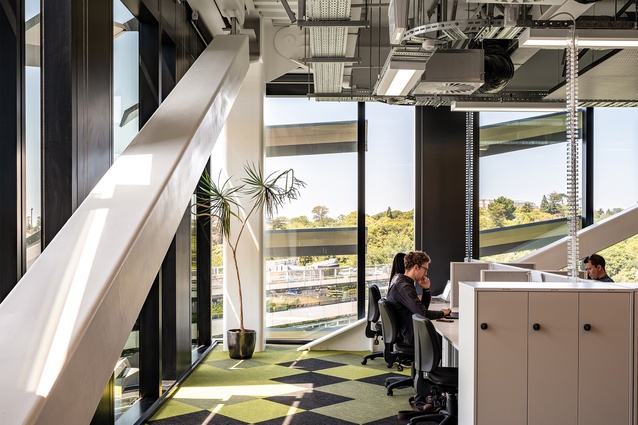Of lollies and eloquent eyebrows
B405, the Jasmax-designed Faculty of Engineering mothership at the University of Auckland, is a building of two halves. Chris Barton comes to terms with its weird façades and, inside, finds some inspiring, cathedral-like spaces.
Up close and from a distance, the University of Auckland’s new Faculty of Engineering, Te Herenga Mātai Pūkaha, aka B405, says, in the immortal words of Rem Koolhaas, “fuck context”. When he said it in S, M, L, XL, Koolhaas was talking about supersized buildings: “Bigness is no longer part of any urban tissue. It exists; at most, it coexists. Its subtext is fuck context.”
B405 by Jasmax exists big time – 114m long, 42m wide and 12-storeys high. Its bulk and prominence on the Symonds Street ridgeline dominates the campus with staunch ‘don’t-mess-with-me’ stance. B405 is the new boss in town, the new centre of the University, making the previous centre, the adjacent Edward Scissorhands cutting and thrusting Auckland Business School look positively puny. At a cost of $224 million, this is a building that can afford to swagger.
And swagger it does: pragmatic, fit-for-purpose, an agent for the global neo-liberal university wearing some very strange clothes. On its eastern side, looking across the motorway out to the Auckland Domain, Parnell and the Waitematā, the big guy is wearing a furry cloak, feathers perhaps. Sometimes, I see an array of eloquent eyebrows. From a distance, it’s a weather map of isobars and frenetic wind-direction arrows.
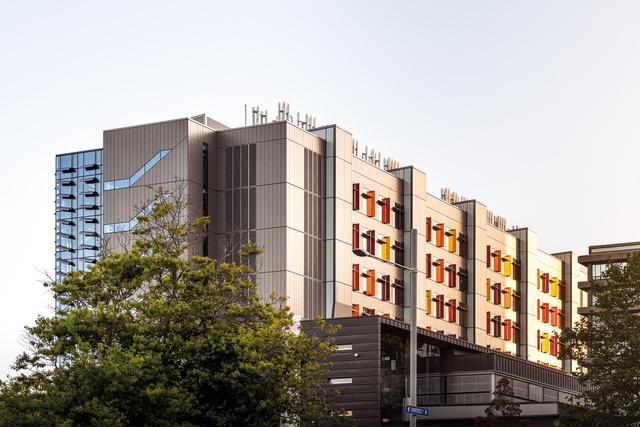
Multiple readings are OK. On the site visit, the architects talk about a façade based on vortex diagrams representing thermo-fluid dynamics. That is, showing visual patterning from the faculty’s different disciplines and articulating that data. The engineers seem to get it. Some see the airflow off the back of Formula 1 race cars in wind-tunnel drag-testing. Others the shoaling of fish. Or the murmuration of birds –when multitudes of starlings fly in swooping, intricately coordinated patterns. Fair enough.
There is an element of play and beauty about the building, says Jasmax’s principal in charge, Chris Scott. He sees the east face as “quite jewel-like” and kinetic in the way it catches the moving sun throughout the day. Lead architect Kimberly Browne says the fins are scripted direct-light parameters provided by the services engineer: “It’s a balance of trying to keep out the light but maintain the views.”
Scott Banks, a walking encyclopaedia of Auckland’s Faculty of Engineering, thanks to some 11,800 hours on B405 and working on the University’s various sites over 10 years, says the 486 aluminium sunshades are all the same size but differ in their positioning angle, which varies from horizontal to 30 degrees.
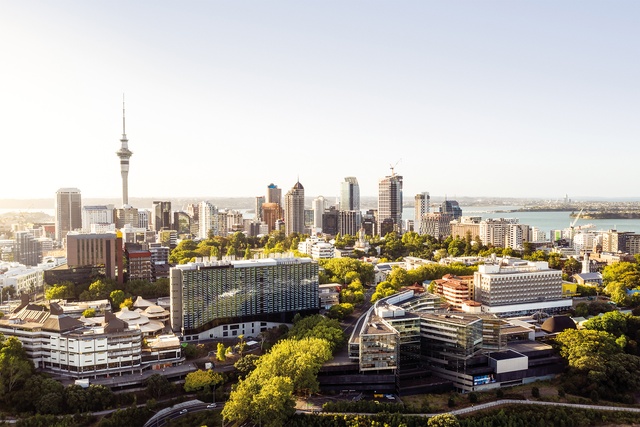
Then there’s the completely different outfit the building dons on its west-facing Symonds Street frontage – solid, with repeating flue shafts and discrete windows punched out of the zinc-clad, unitised façade.
All along the face, like translucent bonbons at regular intervals, are huge, hanging sheets of different-coloured glass. The façade, behind the existing ’70s tower with its hanging frisbee entrance, is more about talking to the rest of the University, says Browne. Yes, but what exactly are the coloured lollies saying?
“This is a building of two halves, which is expressed on the outside,” says Scott. “There is the specialist half to the west and the more general part to the east, over the park. It’s the expression of those two functions. That programmatic response is reflected in the building.” Façade follows function.
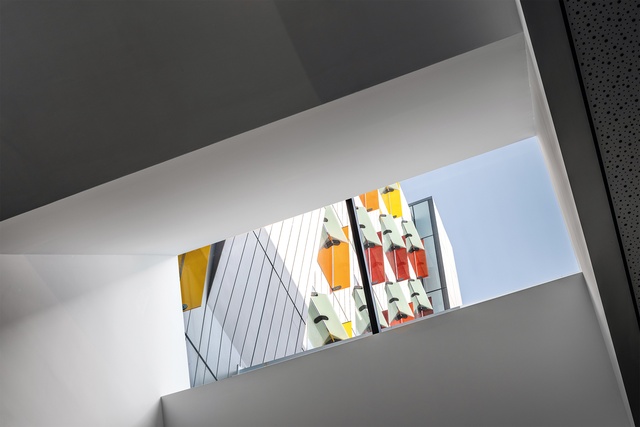
I’m not so sure. Koolhaas: “In Bigness, the distance between core and envelope increases to the point where the façade can no longer reveal what happens inside.” That means the humanist expectation of “honesty” is doomed and interior and exterior architectures become separate projects. “Bigness transforms the city from a summation of certainties into an accumulation of mysteries. What you see is no longer what you get.”
You could argue it’s only the south and north façades, with their stair towers and nifty foot-level glazing strips, that honestly represent the vertical circulation function within. But, even here, there’s no hint of the central lift core – a generous, winding red stairway that is the real circulation of the building.

One part of B405, however, clearly does reference context and history. A sheltered entry foyer and three-level glazed atrium at the Grafton Road frontage connects the new and existing ’70s Symonds Street buildings. Its conversation with the Business School across the road is clear – recently reinforced by a pedestrian crossing. The connection underscores the current vogue for a university as a machine for business rather than as a place for higher learning or as a vibrant nexus of ideas.
But, it’s the landscaped forecourt and its pou whenua, carved by Delani Brown, that really signals the Faculty of Engineering’s unique place in Aotearoa and the Pacific. The pou addresses the rare pounamu artwork Te Toka Kāmaka o Waipārūrū in the entrance of the Sir Owen G Glenn Building.
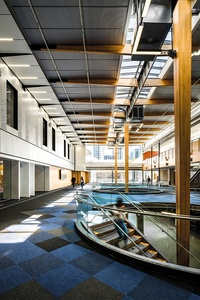
The new entrance also confronts history. Back in the 1970s, Auckland engineering students, as part of their annual capping day celebrations, publicly performed fake haka, wearing grass skirts and brown face. That stopped in 1979, after students with obscenities painted on their bodies were confronted by Māori activist group He Taua. At the opening of the new building and unveiling of the pou, staff and students of the faculty performed a new haka, Me Hoki Whakamuri Kia Anga Whakamua. Dean of Engineering Nic Smith acknowledged the previous tumultuous relationship with the haka: “This is about us standing together, acknowledging our past and simultaneously embracing the challenges of the future.” Attending the dawn blessing, former MP Hone Harawira, who was a member of He Taua, said: “There was an apology some years ago but this new haka topped that.”
The base of the building at the new Grafton Road entrance is ribbed precast concrete, crafted by hand-broken edges of the ribs (broken with both left-handed and right-handed builders so they didn’t look mono-directional – yes, really). The hardness of the 114m concrete base along its eastern face, which houses “dirty teaching spaces” (such as structural engineering involving pouring concrete beams and breaking them), is disrupted by long raking elements at both ends – the southern end following the seating pitch of a new 250-seat lecture theatre.
Climbing the wide stairs from the new atrium entrance takes you to the social heart of the building and to what may be the best communal student space on campus: a huge, cathedral-like cube cantilevered over the entrance. Glazed to the north and east and shaded by angled fins that enhance spectacular views to the domain and the harbour, the space can house about 300 students and includes wide-tiered seating space for students to meet, work or just enjoy the ambience. It also connects to and complements the existing, airy two-level timber atrium to the rear of the Symonds Street tower.
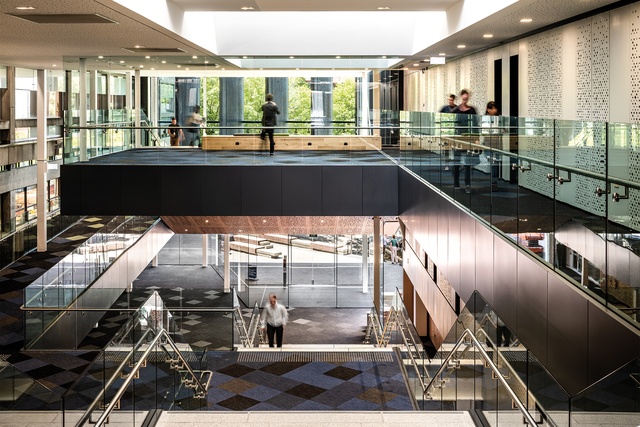
Such spaces are essential because B405 is, in essence, a 32,000m² engineering research and teaching factory. On a normal day, it hums with 4000 students. When I visit, just before Covid lockdown, the building feels eerily empty.
On the lowest five levels are five types of ‘plug and play’ modular teaching laboratories, 26 in all. But it’s the upper six levels of 28 specialised modular research laboratories, for over 40 distinct research streams, that really show what this building is about. They’re modular because research is an ever-changing beast and labs need to adapt and be remade, often every six months. They’re also complex – ‘wet’ facilities for heavy-duty chemistry and science require specific services-spanning airflow and extraction systems, lighting and UV sterilisation and reticulated gases. Plus, micro-grids for wind turbines and photovoltaics, clean rooms and hologram rooms.
Alongside the labs, designed in conjunction with Lab-works Architecture, are spaces for specialised support facilities, post-graduate research, staff collaboration and write-up zones. Looking through the eyebrow sunshades, these, too, have some of the most spectacular panoramic views in Auckland. But, with PhD write-ups being on computer screens, the views are often literally ‘turned off’ by drop-down blinds.
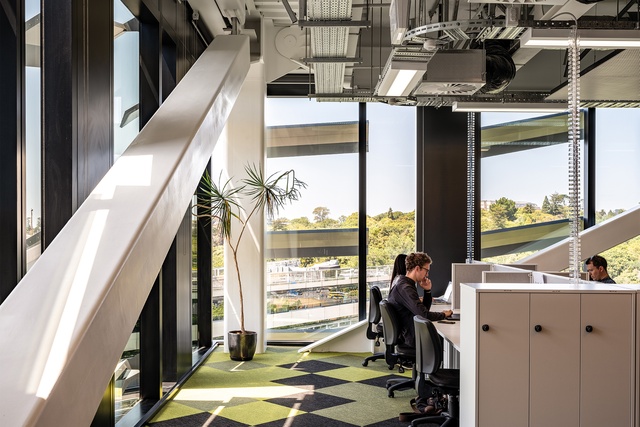
B405 also embraces the theme of ‘visible engineering’ to illustrate engineering concepts inherent in the building. Strain gauges display information about the ever-present invisible forces acting on the building. Unmissable are huge, buckling-restrained braces (BRBs) and structural frames exposed on every floor. Components of yielding, the BRBs are a kind of structural slink, acting like a shock absorber. Portions of ceilings are removed to make services visible and glazing turns plant and communications areas into showrooms.
Not so visible, but nonetheless evident, is the unsustainable embodied carbon in B405’s mass of concrete, 3300 tonnes of structural steel, 40km of pipes, 12km of ducts, and 8km of secondary steel beams. Not to mention the mass of concrete and steel demolished in the old engineering building.
That said, the new design goes to a lot of trouble to be more operationally sustainable and has been designed to last 80 years, to a seismic standard that ensures business continuity following a major earthquake. B405, big enough to play by its own rules, creates its own engineering ecosystem. Fortunately, especially on the inside, it also creates some inspiring architecture.

